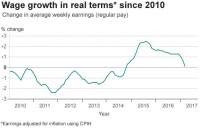 Wages Growth Flagging
Wages Growth Flagging
The unemployment rate was 4.7% in the 3 months to February 2017, down from 5.1% a year earlier; it has not been lower since June to August 1975. Strong demand for labour is translating into a shift from part-time to full-time employment, and an increase in the average hours worked per week by both full time and part-time employees. The number of vacancies increased by 2.1% between the last quarter of 2016 and the first quarter of 2017 to 767,000, the highest level on record. A continued pick-up in consumer price inflation sees annual real wage growth weaken to its lowest rate since 2014.
Work and Pensions Secretary Damian Green said: "More people are finding full-time jobs and average wages have grown yet again, meaning more families have the security of a regular wage.
More people are in work but wages are being spread over a larger number of people. UK productivity continues to flag and wages are falling behind inflation. Ruthless benefit cuts are trying to cut the debit and force people into these unrewarding jobs. People with benefits frozen for four years are being hit hard.
1 comment
Leave a comment
Make sure you enter all the required information, indicated by an asterisk (*). HTML code is not allowed.
Join
FREE
Here










